

Most ebook files are in PDF format, so you can easily read them using various software such as Foxit Reader or directly on the Google Chrome browser.
Some ebook files are released by publishers in other formats such as .awz, .mobi, .epub, .fb2, etc. You may need to install specific software to read these formats on mobile/PC, such as Calibre.
Please read the tutorial at this link: https://ebookbell.com/faq
We offer FREE conversion to the popular formats you request; however, this may take some time. Therefore, right after payment, please email us, and we will try to provide the service as quickly as possible.
For some exceptional file formats or broken links (if any), please refrain from opening any disputes. Instead, email us first, and we will try to assist within a maximum of 6 hours.
EbookBell Team

4.7
96 reviewsThis book is actually a product of efforts of many people, not only of the authors. W ide investigations of marine mammals began in Russia (that time, in the former Soviet Union) in the 1960s when a few teams of enthusiasts founded in captivity experimental stations intended for keeping dolphins and seals and for performing experimental studies of these fascinating animals. It was a time when attention of many people throughout the world was attracted to dolphins and other marine mammals due to appearance of oceanariums and dolphinariums, which demonstrated unique capabilities of these animals. So scientists in many countries concentrated on studies of them. There was much to learn about the morphology, physiology, and psychology of marine mammals, and investigators spending their time and efforts on studies in this field were rewarded by a number of surprising findings. The authors of this book represent one of such research teams focused on the neuro- and sensory physiology of marine mammals. A few decades of studies naturally resulted in the idea to summarize in a book both the results of these studies and a large body of data in adjacent fields. Our goal was to synthesize the many research findings and the present knowledge on sensory capabilities and mechanisms of sensory systems of aquatic mammals. We realize, however, that the appearance of this book was made possible due to the help and assistance of many colleagues.